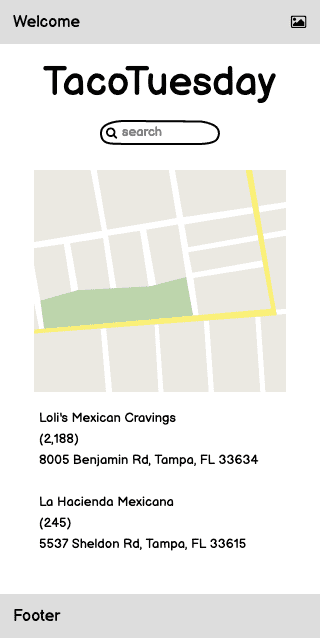Start With User Stories and a Wireframe
Reading
Getting Started
With any application, we should start by gathering the general user stories for our application. In this case, we would like to collect all the taco producers in town in an organized way while allowing users to rank and review them.
As such, our user stories might be something like the following:
- As a user, I should be able to view and search for taco restaurants.
- As a user, I should be able to view the details of a specific restaurant,
including:
- Name
- Description
- Address and phone number
- A list of reviews
- The average rating
- As a user, I should be able to post a new taco restaurant.
- As a user, I should be able to review an existing restaurant.
- As a user, I should be able to rate a restaurant.
Generate a wireframe
Based on the user stories, we should generate a rough wireframe of the user interface that would support these features. We would try to imagine a user experience that would make a usable application that implements the "Minimum Viable Product".
For an application we expect to charge users for, this would be the least amount of features and thus effort for which they would pay us. For an application that we are building for private or internal use; this would be the least amount of features that our users would adopt the system in place of whatever system they are presently using.

Via https://brianpagan.net/2015/lean-startup-mvp-how-to-make-meaningful-products/
Here we see the elements an application requires.
- Functionality: The actual functions of the system must exist and do what they claim they do
- Reliable: The system must be reliable. It must stay running, and it must be resistant to user input errors, return the data the user expects, and not lose existing data during the development process.
- Usable: Users should be able to learn the system and use it quickly. It must not be cumbersome, certainly not more cumbersome than the system it replaces.
- Emotional Design: The design of the system must inspire users to want to use the application. It must anticipate the user's needs and be consistent in its behavior and responses.
These are lofty goals, and we cannot focus the entire time on any one level of this pyramid. We must iterate through vertical slices as we visit each function of our application. When working on each part of the system, we want to include all four aspects in some amount. As we proceed through the features, we will make discoveries that will allow us to revisit each of these aspects. Through iteration, certain features and functions become unnecessary, saving us a tremendous amount of time.
No code is more simple to develop and executes more efficiently than code you never have to write.
Home Page Wireframe
ERD
From these wireframes, we can collect the details of the entities the system needs to represent. From the user stories and wireframes, we can discover the following entities:
and
and we would describe the relationships between these two entities as:
Validate the ERD
Validate that this ERD supports the data on the wireframes we have generated in the previous step. See if you can identify what entities and potentially what queries, create the data on each of the pages. What information does the page need to operate? For instance, a page showing the details of a single restaurant will require the restaurant ID (which we'll likely get from the URL and React Router) The main listing page will need a collection of many of the restaurants, perhaps filtered by a phrase.
